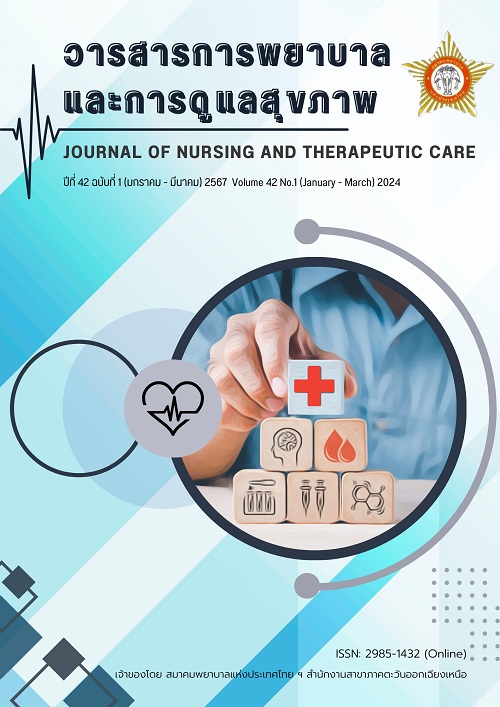ปัจจัยการรับรู้ด้านสุขภาพและพฤติกรรมการป้องกันโรคติดเชื้อทางเดินหายใจส่วนบนของผู้ดูแลเด็กวัยก่อนเรียน อำเภอเมือง จังหวัดศรีสะเกษ
คำสำคัญ:
โรคติดเชื้อทางเดินหายใจส่วนบน, ความรอบรู้ด้านสุขภาพ, ผู้ดูแลเด็ก, เด็กวัยก่อนเรียนบทคัดย่อ
การวิจัยภาคตัดขวางนี้มีวัตถุประสงค์เพื่อศึกษาความสัมพันธ์ระหว่างการรับรู้ด้านสุขภาพกับพฤติกรรมการป้องกัน โรคติดเชื้อทางเดินหายใจส่วนบนในผู้ดูแลเด็กวัยก่อนเรียน กลุ่มตัวอย่างเป็นบิดามารดาผู้ปกครองของเด็กวัยก่อนเรียน จำนวน 188 คน ที่อาศัยอยู่ในตำบลหนองแก้ว อำเภอเมือง จังหวัดศรีสะเกษ เลือกแบบเฉพาะเจาะจง 12 หมู่บ้าน เครื่องมือวิจัยประกอบด้วย 1) แบบสอบถามข้อมูลส่วนบุคคลของผู้ดูแลเด็กและเด็ก 2) แบบสอบถามการรับรู้ด้านสุขภาพ 5 ด้าน ได้แก่ การรู้รับโอกาสเสี่ยงของการเกิดโรค การรับรู้ความรุนแรงของโรค การรับรู้ประโยชน์ของการปฏิบัติ การรับรู้ต่ออุปสรรคของการปฏิบัติ การรับรู้ความสามารถของตนเอง 3. แบบสอบถามพฤติกรรมการป้องกันการติดเชื้อโรคระบบทางเดินหายใจส่วนบนในเด็กวัยก่อนเรียน 5 ด้าน แบบสอบถาม ที่สร้างขึ้นมีความตรงตามเนื้อหาเท่ากับ 0.90 และทดสอบความเชื่อมั่นจากกลุ่มตัวอย่าง 30 คน ได้ค่าสัมประสิทธิ์แอลฟ่า ของครอนบาคเท่ากับ 0.78 วิเคราะห์ข้อมูลโดยใช้สถิติพรรณนาและสถิติสัมประสิทธิสหพันธ์ของเพียร์สัน
ผลการศึกษาพบว่าผู้ดูแลเด็ก จำนวน 188 คน ส่วนใหญ่เป็นเพศหญิง คิดเป็นร้อยละ 97.90 พฤติกรรมการป้องกัน โรคติดเชื้อทางเดินหายใจส่วนบนของผู้ดูแลเด็กวัยก่อนเรียนภาพรวมอยู่ในระดับปานกลาง การรับรู้ด้านประโยชน์ของการปฏิบัติ มีความสัมพันธ์ทางบวกกับพฤติกรรมการป้องกันโรคติดเชื้อระบบทางเดินหายใจในด้านการดูแลเกี่ยวกับโภชนาการและ ด้านการรักษาความอบอุ่นร่างกายเด็ก อย่างมีนัยสำคัญทางสถิติ p< .01 ตามลำดับ การรับรู้ด้านความสามารถของตนเอง มีความสัมพันธ์ทางลบกับพฤติกรรมการป้องกันโรคติดเชื้อในด้านการดูแลให้ออกกำลังกายและการพักผ่อน อย่างมีนัยสำคัญทางสถิติ p< .01 ผลการศึกษาครั้งนี้เป็นประโยชน์ในด้านการใช้ข้อมูลในการวางแผนจัดการป้องกันการติดเชื้อทางเดินหายใจส่วนบน ในสังคมไทยอย่างมีประสิทธิภาพต่อไป
Downloads
เอกสารอ้างอิง
Jain N, Lodha R, Kabra SK. Upper respiratory tract infections. Indian J Pediatr. 2001;68(12):1135-8.
World Health Organization. The top 10 cause of death. [internet]. Geneva: WHO; 2020 [cited 2024 Feb 23]. Available from: https://www.who.int/news-room/fact-sheets/detail/the-top-10-causes-of-death.
Caballero MT, Bianchi AM, Nuno A, Ferretti AJP, Polack LM, Remondino I, et al. Mortality associated with acute respiratory infections among children at home. J Infect. Dis. 2019;219(3):358-64.
National Statistical Office. Analysis of children and youth. Ministry of Information and Communication Technology. [internet]. Bangkok: NSO; 2015 [cited 2024 Mar 12]. Available from: https://www.nso.go.th/nsoweb/storage/ebook/2023/20230506151220_25133.pdf (in Thai).
Bhudhisawasdi K, Leelasethe T, Teeratakulpisarn J. Natural history of the common cold with respect to day-care attendance at a University Hospital in Khon Kaen, Thailand. Srinagarind Medical Journal. 2009;24(3):260-4. (in Thai).
Prayoonmahisorn S, Unahalekhaka A, Chitreecheur J. Development of self learning package for infection prevention among child care providers in child development center. Nursing Journal 2013;40(4):34-44. (in Thai).
Hothan KA, Alawami MA, Baothman EA, Alghanem FA, Al-Haddad DM, Daerwish RIA, Albetiyan ZA, Alghanem GA, Bayazeed KA, Yusuf GAA, Aljurfi AM. Types of upper and lower respiratory tract infection in pediatrics. Int J Community Med. Public Health. 2022;9(12):4689-93.
Issa RM, AlSharif RA, Heddawi AIH, AlRefai AK, AlZaid FY, Zahirah MOA, et al. Respiratory Tract Infection in the Pediatric Age Group. World J Environ Biosci. 2022;11(4):38-41.
Emeryk A, Vallet T, Wawryk-Gawda E, Jedrzejewski A, Durmont F, Ruiz F. Acceptability of a Sublingual Drug Formulation for Respiratory Tract Infections in Children Aged 3 to 5 Years. Pharmaceutics 2021;13(294):1-12.
Khan EA, Raja MH, Chaudhry S, Zahra T, Naeem S, Anwar M. Outcome of upper respiratory tract infections in healthy children: Antibiotic stewardship in treatment of acute upper respiratory tract infections. Pak J of Med Sci. 2020;36(4):642-6.
Qureshi MA, Qureshi MA, Ismail MM, Aamir S, Khan RA, Rana M. Upper Respiratory Infections among Under-Five Age Group Children at Urban Slum, Islamabad. Pak J Med Health Sci. 2022;16(10):693-4.
Ministry of public health. Influenza situation. Department of disease control. [internet]. Bangkok: MOPH; 2021[cited 2024 Feb 23]. Available from: https://ddc.moph.go.th/uploads/files/1564820201116030358.pdf (in Thai)
Hockenberry MJ, Wilson D, Rodgers CC. Wong's essentials of pediatric nursing. 11st ed. Elsevier Health Sciences; 2021
Wongyai J. Activities provided for promoting health, growth and development of children in day care centers with in Chiang Mai Municipality [dissertation]. Chiang Mai: Chiang Mai University; 1996. (in Thai).
Jaide C, Santati S, Kongsaktrakul C. Factors related to child care workers' behavior prevention of acute respiratory infection in child care centers. Ramathibodi Nursing Journal 2012;18(3):389-403. (in Thai).
Becker MH. The health belief model and personal health behavior. New Jersey: Charles B.Slack; 1974.
Kalampakorn S. An application of concepts and theories to health promotion. In Powwattana A, Kalampakorn S, Lagampan S, Amnatsatsue K. editor, health promotion and disease prevention in community: An application of concepts and theories to practice 2nd ed. Bangkok: Klungnana; 2012. (in Thai).
Janz NK, Becker MH. The health belief model: A decade later. Health Educ. Q. 1984;11(1):1-47.
Rosenstock IM, Stretcher VJ, Becker MH. Social learning theory and the health belief model. Health Educ Q. 1988;15(2):175-83.
Jiang l, Liu S, Li h, Xie L, Jiang Y. The role of health beliefs in affecting patients' chronic diabetic complication screening: a path analysis based on the health belief model. J Clin Nurs. 2021;30(19-20):2948-59.
Stretcher VJ, Rosenstock IM, The Health Belief Model. In K, Glanz FM, Levis, BK. Rimer. editors. Health behavior and health education: Theory, Research and practice. 2nd edition. San Francisco: JosseyBass; 1997.
Kitreerawutiwong N. Public health research: from principle to practice. 2nd edition. Phitsanulok: Naresuan University; 2018. (in Thai).
Thangthong S. Factors related to illness preventive behavior and care of rural mothers to children with acute respiratory infection [dissertation]. Khonkaen: Khonkaen University; 1998. (in Thai).
Bloom BS. Handbook on formative and summative evaluation of student learning. New York: McGraw-Hill; 1971.
Polit DF, Beck CT. Nursing research generating and assessing evidence for nursing practice 11th ed., Philadelphia: Wolters Kluwer; 2021.
Sanders LM, Shaw JS, Guez G, Baur C, Rudd R. Health literacy and child health promotion: Implications for research, clinical care, and public policy. Pediatrics 2009;124(supplement 3):S306-14.
Kummee S, Urharmnuay M, Jaikla W, Prapalert K, Chaimakham K. Parental health literacy and behavior on COVID-19 prevention in child development center. Journal of the Police Nurses 2022; 14(1):14-23. (in Thai).
Katanyutanon T, Thongsiri T, Pichitchainarong A, Kingdokmai T, Thammakul S, Saenkamrang P, et al. Factors related to COVID-19 preventive behaviors among health science students of Huachiew Chalermprakiet University. Huachiew Chalermprakiet Science and Technology Journal 2021;7:1-13. (in Thai).
ดาวน์โหลด
เผยแพร่แล้ว
รูปแบบการอ้างอิง
ฉบับ
ประเภทบทความ
สัญญาอนุญาต
ลิขสิทธิ์ (c) 2024 วารสารการพยาบาลและการดูแลสุขภาพ

อนุญาตภายใต้เงื่อนไข Creative Commons Attribution-NonCommercial-NoDerivatives 4.0 International License.



